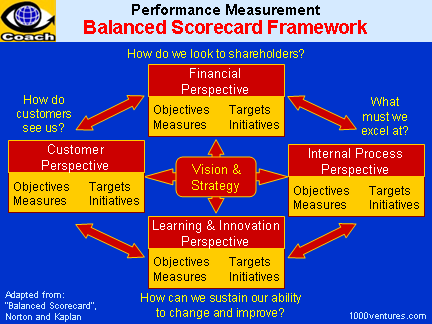
|
The Four Perspectives Are Designed To
Balance |
-
the internal and external
-
the financial and non financial
-
past performance with the future
|
|
Main Applications1 |
|
Implementing a balanced performance
measurement system can have far-reaching effects on your organization.
It can be used for:
-
deciding what the key drivers of
performance are
-
refocusing and stimulating activity on these key business drivers
-
drawing attention to goals and targets
-
creating a culture of achievement
-
noticing in advance any trends affecting the business so that changes
can be made in good time
|
|
Shortcomings of the
Balanced Scorecard1 |
|
As the Balanced Scorecard (BSC) is not a
multiple stakeholder framework:
-
Suppliers are
excluded:
through
suppliers may be considered within the Process Perspective, this
approach does not give suppliers the visibility they now deserve,
especially in
new business models characterized by outsourcing of almost all
non-core functions and
vertical integration
-
Regulators are ignored: many
non-negotiable standards have to be met, but they do not fit into
the Balanced Scorecard's framework.
-
Community and environmental issues are
missing: nowadays
environmental issues and local communities are closely linked
and companies need to measure and monitor the impact they are
having. If they don't, they may find themselves subject to attack by
pressure groups who can damage the companies' reputation and
ultimately destroy the business.
-
Competitors are ignored: Besides
shareholders and customers, companies need to monitor the
business environment to
track the competitor activity and technology. BSC is designed to
answer the efficiency question, 'Is the chosen strategy being
implemented?' but fails to ask the effectiveness question, 'Is the
chosen strategy the right strategy for our business?' It does not
monitor threats from non-traditional or future competitors.
|
|
What is Balanced Scorecard?
The balanced scorecard advocates a top-down
approach to business performance management, starting with business
strategic intent expressed
through the organization down to operationally relevant targets. The focus
with Balance Scorecard approach is on the link and/or influences between it
various components, which include business
strategy, perspectives, objectives, measures, initiatives and milestones
as well as softer contextual information.
Why Balanced Scorecard?
To survive and prosper in
today's world,
companies can no longer manage using financial measures alone. You have to
track non-financial measures such as
speed of response and
product
quality;
externally focused measures, such as
customer satisfaction and
brand
preference; and forward looking measures, such as
idea management and
employee satisfaction.
The Balanced Scorecard is an important tool of
your
strategic management system. It uses
performance measurements within a
framework of strategic hypotheses that enables you to learn what works best
in your organization.
Organizational Balanced
Scorecard
The organizational balanced
scorecard encompasses the organizational
vision,
mission, core
values,
critical success factors, objectives, performance measures, targets and
improvement actions. This corporate scorecard is communicated and translated
into all business unit balanced scorecards, team balanced scorecards and the
performance plans of individual employees and their
personal balanced
scorecards. In connection with this policy deployment, each employee is
stimulated to contribute to the shared
organizational strategy.
Balanced Organization: 5 Basic Elements
Water
(Performance Management):
A Range of Strategic and
Operational Measures
The measures used to manage the performance of
a business comprise a range of strategic measures. The include the
following:
-
Strategic measures:
market attractiveness (industry structure, growth, concentration,
innovation, customer power, logistical
complexity) and competitive strength (relative market share, relative
quality; intellectual property, customer
coverage).
-
Organizational measures:
culture,
leanness,
incentives, training and development, structure, purpose,
process.
-
Operational measures:
customer satisfaction,
product or service excellence, capacity utilization, capital intensity,
productivity,
outsourcing.
Depending on the emphasis placed on different
measures in an organization, its information and performance measures can
vary between operational fixed (for example, the 99% replenishment rate on
the shelves of a Sainsbury's store) and strategic flexible (for example,
Microsoft's goal of standards ownership on the information superhighway).2
A Framework for Designing a
Set of Measures
The Balanced Scorecard provides a framework for
designing a set of measures for activities chosen by you as being the key
drivers of your business. By having four distinct perspectives (financial,
customer, internal process and innovation and learning) it promotes a more
holistic balanced view of any organization. By creating your own measures
under each of these headings, no important area would be missed.
The Balanced Scorecards itself is just a
framework and it doesn't say what the specific measures should be. "That is
a matter for people within the organization to decide, and the set of
measures for each organization (or even sections within the same
organization) will be different. Much of the success of the scorecard
depends on how the measures are agreed, the way they are implemented and how
they are acted upon. So, the process of designing the scorecard is just as
important as the scorecard itself."1
|